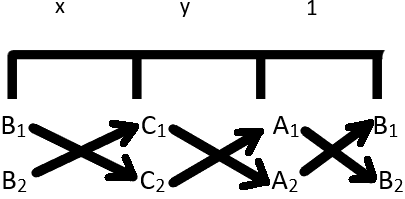Subscribe to our ▶️ YouTube channel 🔴 for the latest videos, updates, and tips.
Method of Cross Multiplication
The next
method of solving linear equations in two variables that we are going to learn
about is method of cross multiplication.
Let us see the steps followed while soling the linear equation by method of cross multiplication:
Assume two linear equation be
A1 x + B1y + C1 = 0, and
A2x + B2y + C2 = 0.
The coefficients of x are: A1 and A2.
The coefficients of y are: B1 and B2.
The constant terms are: C1 and C2.
To solve the equations in a simplified way, we use following table:
\(\frac{x}{B_{1}C_{2} - B_{2}C_{1}} = \frac{y}{C_{1}A_{2} - C_{2}A_{1}} = \frac{1}{A_{1}B_{2} - A_{2}B_{1}}\)
Equating one another we find the value of x and y of the given equations.
Let us solve some examples based upon this concept:
1. Solve for ‘x’ and ‘y’:
3x + 2y + 10 = 0, and
4x + 5y + 20 = 0.
Solution:
Let us solve the given equations using method of cross multiplication:
The coefficients of x are 3 and 4.
The coefficients of y are 2 and 5.
The constant terms are 10 and 20.
The table can be formed as:
\(\frac{x}{B_{1}C_{2} - B_{2}C_{1}} = \frac{y}{C_{1}A_{2} - C_{2}A_{1}} = \frac{1}{A_{1}B_{2} - A_{2}B_{1}}\)
On substituting respective values, we get:
\(\frac{x}{2 × 20 - 5 × 10} = \frac{y}{10 × 4 - 20 × 3} = \frac{1}{3 × 5 - 4 × 2}\)
\(\frac{x}{-10} = \frac{y}{-20} = \frac{1}{7}\)
Equating x term with constant term, we get x = -\(\frac{10}{7}\).
On equating y term with constant y term, we get y = -\(\frac{20}{7}\).
2. Solve for x and y:
6x + 5y + 15 = 0, and
3x + 4y + 9 = 0.
Solution:
Let us solve the given equation using method of cross multiplication:
The coefficients of x are 6 and 3.
The coefficients of y are 5 and 4.
The constant values are 15 and 9.
The table can be formed as:
\(\frac{x}{B_{1}C_{2} - B_{2}C_{1}} = \frac{y}{C_{1}A_{2} - C_{2}A_{1}} = \frac{1}{A_{1}B_{2} - A_{2}B_{1}}\)
On substituting respective values, we get;
\(\frac{x}{5 × 9 - 4 × 15} = \frac{y}{15 × 3 - 9 × 6} = \frac{1}{6 × 4 - 3 × 5}\)
\(\frac{x}{-15} = \frac{y}{-9} = \frac{1}{9}\)
On equating x term with constant term, we get x= \(\frac{-15}{9}\), i.e., x = -\(\frac{5}{3}\).
On equating y term with constant term we get, y = \(\frac{-9}{9}\)
= -1.
3. Solve for x and y:
5x + 6y + 10 = 0, and
2x + 9y = 0.
Solution:
The coefficients of x are 5 and 2.
The coefficients of y are 6 and 9.
The constant terms are 10 and 0.
The table can be formed as:
On solving, we get:
\(\frac{x}{B_{1}C_{2} - B_{2}C_{1}} = \frac{y}{C_{1}A_{2} - C_{2}A_{1}} = \frac{1}{A_{1}B_{2} - A_{2}B_{1}}\)
On substituting respective values, we get;
\(\frac{x}{6 × 0 - 9 × 10} = \frac{y}{10 × 2 - 0 × 5} = \frac{1}{5 × 9 - 2 × 6}\)
\(\frac{x}{-90} = \frac{y}{20} = \frac{1}{33}\)
On equating x term with constant term, we get x = \(\frac{-90}{33}\) = -\(\frac{30}{11}\).
On equating y term with constant term we get, y = \(\frac{20}{33}\).
4. Solve for x and y;
x + y + 10 = 0.
3x + 7y + 2 = 0.
Solution:
The coefficients of x are 1 and 3.
The coefficients of y are 1 and 7.
The constant terms are 10 and 2.
The table can be formed as:
On solving this table we get,
\(\frac{x}{B_{1}C_{2} - B_{2}C_{1}} = \frac{y}{C_{1}A_{2} - C_{2}A_{1}} = \frac{1}{A_{1}B_{2} - A_{2}B_{1}}\)
On substituting respective values, we get;
\(\frac{x}{1 × 2 - 7 × 10} = \frac{y}{10 × 3 - 2 × 1} = \frac{1}{1 × 7 - 3 × 1}\)
\(\frac{x}{-68} = \frac{y}{28} = \frac{1}{4}\)
On equating x term with the constant term, we get; x = \(\frac{-68}{4}\) = -17
On equating y term with the constant, we get; y = \(\frac{28}{4}\) = 7
From Method of Cross Multiplication to HOME PAGE
Didn't find what you were looking for? Or want to know more information about Math Only Math. Use this Google Search to find what you need.



New! Comments
Have your say about what you just read! Leave me a comment in the box below. Ask a Question or Answer a Question.